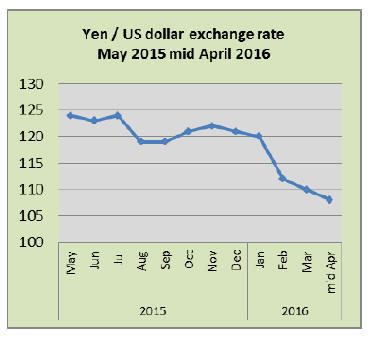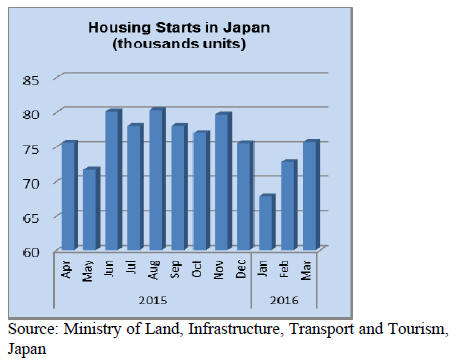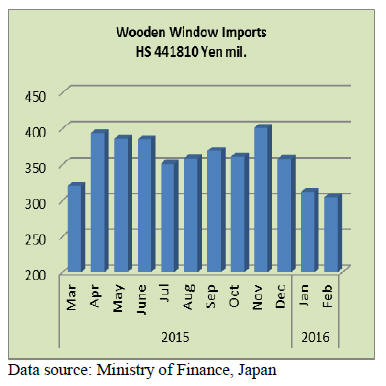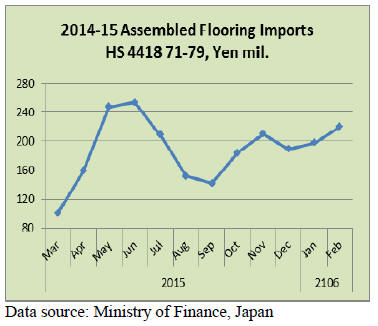Japan
Wood Products Prices
Dollar Exchange Rates of 25th
April 2016
Japan Yen 111.20
Reports From Japan
Massive rescue and recovery in progress
On Saturday 16 April a magnitude 7.3 earthquake was the
first of several severe quake to devastate parts of
Kumamoto Prefecture in Japan’s western island of
Kyushu.
The epicenters of the two most damaging earthquakes
were directly below a densely populated urban area. The
latest count puts the death toll at 50 with over 13,000
homes being completely destroyed and another 15,000
seriously damaged.
Experts point out that in contrast to the March 2011
magnitude 9 earthquake which struck in north east Japan,
the result of deep tectonic plate movements, the quakes
that are still battering Kumamoto have a shallow focus
which tends to concentrate the damage in a small area.
Japan is preparing an extra budget said to be over US$4
billion for relief and reconstruction in areas affected this
month's deadly earthquakes.
Delay in sales tax increase becomes more likely
In its latest assessment of economic prospects the
government maintained an optimistic view but said it was
analysing what impact the recent disaster will have since
thousands of homes and businesses have been destroyed.

The government lowered its assessment of corporate
sentiment after the recent Tankan survey showed
companies were less optimistic about business conditions
in the first quarter of this year. A statement from the
Cabinet Office says “Japan's economy remains on track
for recovery, but more weak spots can be seen" .
Some analysts expect the economy to weather the impact
of the recent earthquakes but caution that the Prime
Minister may use the event as a reason to delay the rise in
sales tax early next year, particularly as consumer
sentiment is stalling.
See-sawing yen/dollar exchange rate
The yen/dollar exchange rate see-sawed prior to, and then
after the monthly Bank of Japan (BoJ) Board meeting.
The financial markets had expected the BoJ to come with
further measures to weaken the yen which had gained
around 5% on the US dollar in the days running up to the
BoJ meeting.
To everyone’s surprise the BoJ maintained a neutral stance
which sent the yen soaring higher to an 18 month high
against the dollar.
A strong yen hurts Japanese exporters and puts downward
pressure on import prices, both effects the opposite of
what the BoJ and government are aiming for.

Quake resistant housing
Japan regularly experiences earthquakes being a very
seismically active country and as a result has, over the
years, developed rigorous earthquake building standards.
The current regulations date back to the 1981 Building
Standards Law and subsequent revisions. The evidence
from the Tohoku and Kobe quakes showed that the 1981
standards were sufficient as most of the damage occurred
to homes built prior 1950.
Further tightening of the building regulations was made in
2013 requiring owners of large public buildings to have
third party assessment of whether the properties meet the
1981 law.
The aim at the time was to increase to 90% public
properties that met the revised code. In some instances the
government provided support for improvements.
Fast pace housing starts
Data from the Ministry of Land, Infrastructure, Transport
and Tourism indicates that year on year March 2016
housing starts increased by just over 8%.
The expectation was for a slowing in the rate of starts from
the over 7% reported for February. March 2016 starts
marked the third consecutive rise and the fastest pace of
increase since August last year. The Ministry also reported
that orders at the biggest builders increased in March.

Doors
Year on year February 2016 imports of wooden doors fell
almost 3% after the 8% year on year rise in January. Since
December last year Japan’s imports of wooden doors have
been falling.
China remains the main supplier of wooden doors to Japan
followed by the Philippines and Indonesia. These three
suppliers dominate imports of wooden doors accounting
for over 84% of all imports of doors in February. Of note,
Brazil joined the list of countries shipping wooden doors
to Japan.

Windows
Year on year Japan’s February 2016 wooden window
imports were slightly up as they were in January but this
disguises the sharp deline in imports of windows since
November 2015. The level of wooden window imports in
February marked a new low.
The top three suppliers, China (29%), Philippines (24%)
and the US (24%) continue as the main suppliers
accounting for 85% of February 2016 imports.

Assembled flooring
The data below shows imports of three categories of
assembled flooring, HS 441871,72 and 79. Most of
Japan’s imports are of HS441872 with China being the
main supplier followed by Indonesia and Malaysia which
accounted for over three quarters of February imports of
this category.
HS441879 flooring is supplier from Indonesia, China and
Vietnam in order of rank, the three accounted for 88% of
Japan’s imports of this category in February. Japan’s
imports of HS441871 are small with almost all coming
from Indonesia.

Plywood
February 2016 imports of plywood fell back after the
sharp rise reported in January. Year on year February
2016 plywood imports were down 12% and February
imports were down 15% from levels the previous month.
All three of the main suppliers saw February shipments to
Japan fall compared to levels in January; China (-38%),
Malaysia (-20%) and Indonesia (-5%). The top three
suppliers accounted for 93% of all Japan’s February 2016
plywood imports.

Trade news from the Japan Lumber Reports (JLR)
For the JLR report please see:
http://www.nmokuzai.
com/modules/general/index.php?id=7
South Sea (tropical) logs
In Sarawak, Malaysia, rainy season was over but weather
is still unstable with occasional heavy rain in some area. In
the past, log production increases after rainy season is over
and the prices drop but this year log supply seems to be
tight as the suppliers are cautious in dealing with newly
control of illegal harvest so the log supply seems to stay
tight for some time.
The Japanese log importers have hard time to set up
shipping schedule due to very tight supply for quality logs.
Then Indian log buyers are now accepting higher offers by
the suppliers, which affects log prices for Japan.
Also after Malaysian currency ringgit rebounded and got
stronger so the log suppliers are asking higher log prices
but the Japanese are bearish as South Sea hardwood
plywood orders in Japan are weak.
In Sabah, weather is clear and fine so that log production
is steady but India has started buying Sabah logs for the
first time after they shifted to PNG and Solomon Islands to
shy away from spiraling high log prices in Sarawak.
Before India showed up in Sabah, log prices for Japan had
been stable but now it will be the same as Sarawak with
entry of India.
Present log prices in Sarawak for Japan are US$265-275
on meranti regular per cbm FOB, US$245 for small
meranti and US$230 for super small. These seem to be
bottom prices now and will go up.
Fire at Akita Plywood
Fire started at the second plant of Akita Plywood, one of
the largest plywood manufacturers in Japan in the evening
of April 6 then the fire extended to the first plant. The
second plant is totally destroyed by the fire. Fire obviously
started behind dryers then burnt roof and imported veneer
so the fire spread fast then the fire moved to the first plant
but the damage is minor.
Akita Plywood has three plants, the first, second and Oga,
which produce total of about 40,000 cubic meters of
plywood a month. The second plant specialises
manufacturing thick panel with monthly production of
10,000 cbms then the first plant makes 12 mm 3x6 and
floor base with monthly production of 15,000 cbms.
Since Akita Plywood is one of the group companies of
Seihoku group, the group is trying to cover and support
damage of Akita Plywood by increasing production of
other group plants.
The company plans to rebuild the second plant but it
would take about a year before the production resumes.
This gives shock to plywood market and there are some
speculative demand but other plywood mills are now
running in full and have no extra capacity to increase the
production.
Increasing supply of biomass fuel
Sharp increase of number of wood biomass power
generation plants all over Japan after FIT system has
started in July 2012 results in expansion of fuel supply by
large trading firms and subsidiary company of paper
manufacturing companies.
Companies, which have its own power generation plant in
the group or invested for biomass power plants,
aggressively participate in procurement of biomass fuel
which contributes increase of sales. Also wood fuel is used
by coal burning power plants to reduce carbon dioxide
emission.
Handling of wood fuel is one of substituting businesses to
supplement declining business of building materials sales
with decrease of housing starts in future.
Sumitomo Forestry’s fuel supply in 2015 (domestic wood
chip and imported PKS) was 1.2 million cubic meters,
5.3% more than 2014. With increasing number of biomass
power generation plants, supply of PKS sharply climbed
and was more than double of 2014 supply. Monbetsu
Biomass Power (power output of 50,000 kw), which is
jointly operated by Sumitomo Forestry and Sumitomo
Kyodo Electricity, will start up in late December this year
so Fuel supply will increase further more.
Sumitomo Trading’s fuel supply of imported wood pellet
in 2015 was 77,000 ton, 97.4% more than 2014. It had
been supplying for large power companies steadily then
additional supply for biomass power plant, which burns
coal and biomass fuel pushed the total volume up.
The largest wood biomass power plant Sumitomo Trading
owns, Handa Biomass Power (power output of 75,000 kw)
is under construction and will start up in May next year. It
will use coal as supplementary fuel at the beginning but it
will use 100% biomass fuel in future so its annual
necessary biomass fuel will be about 500,000 ton.
Hanwa Co., Ltd. imported about 160,000 ton of PKS in
2015. Oji Forest and Products Co., Ltd. covered decline of
sales of logs, lumber and plywood by increased sales of
paper manufacturing materials and wood biomass fuel in
2015. Nippon Paper Lumber Co., Ltd. increased supply of
fuel chip including PKS to 1,620,000 ton, 17% more than
2014.
It intends to strengthen business of this growing field,
which is not affected by declining housing starts.
|